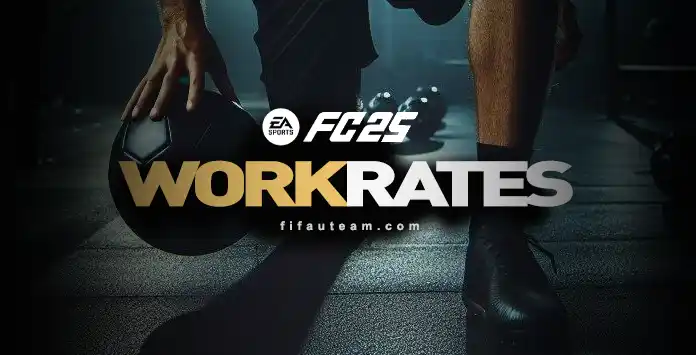FC 25 WORK RATES
Work Rates were responsible to determine how often your player will defend and attack.

Work Rates for FC 25
Constructing an Ultimate Team squad involves considering various factors such as chemistry, positions, attributes, and prices. For those who delve deeper, factors like height, best foot, weak foot, skill moves, and work rates play a crucial role. Contrary to common belief, Work Rates significantly impacted the gameplay of both individual players and the team as a whole. However, not anymore since they were replaced by more complex player roles.
Player Work Rates determined the positioning of players on the field, relative to their original starting point. Classified as low, medium, or high, these rates influenced a player’s involvement in attacks and defenses, even when they were not in their designated positions. Importantly, Work Rates didn’t measure the intensity of a player’s effort in attack or defense but rather the specific areas of the pitch they occupied.
A high attacking work rate indicated a player actively participating in all offensive moves, while a medium rate implied selective involvement in attacks. On the other hand, a player with a low attacking work rate tended to hold their position during team attacks. The same principles applied to defensive work rates, determining a player’s engagement in defensive actions.
To comprehend the impact of work rates, post-game heat maps for each player offered valuable insights. These visual representations clearly illustrated the areas of the pitch where players spent the majority of their time during the game. Understanding and leveraging work rates could be pivotal in optimizing the performance of your Ultimate Team.
Suggestions
When determining the ideal work rate for a player, several factors came into play, including the formation, custom tactics, instructions, attributes, playing style, and the overall composition of the squad.
It doesn’t make sense to recommend work rates for Football Club 25, since they don’t exist anymore, but just to give you an idea, here are our suggestions for each position.
CB | Low/High
These are the players you will need in their natural positions all the time. If you want them to support the midfield, at least do it with fast players.
RB/LB | Medium/High
The main role of fullbacks is to give security to the backline, but most are high/medium, meaning they are out of position too often.
CDM/CM | Medium/High
Once again, these players should focus on the defense without losing the chance to help the most advanced teammates. This work rate should be adjusted according to the number of CDM/CMs in your team.
CAM | High/Medium
Attacking Midfielders have a crucial role in the attacking. However, they should also be the first players to defend.
Wingers | High/Low
As far as possible, it would be best to leave your wingers focused on the attack. It doesn’t mean they cannot help the backline, but other players are more suitable to do it.
ST | High/Low
This is the man responsible for scoring goals. That’s why he should be in the opposite box as long as possible, leaving defensive duties for the other players.